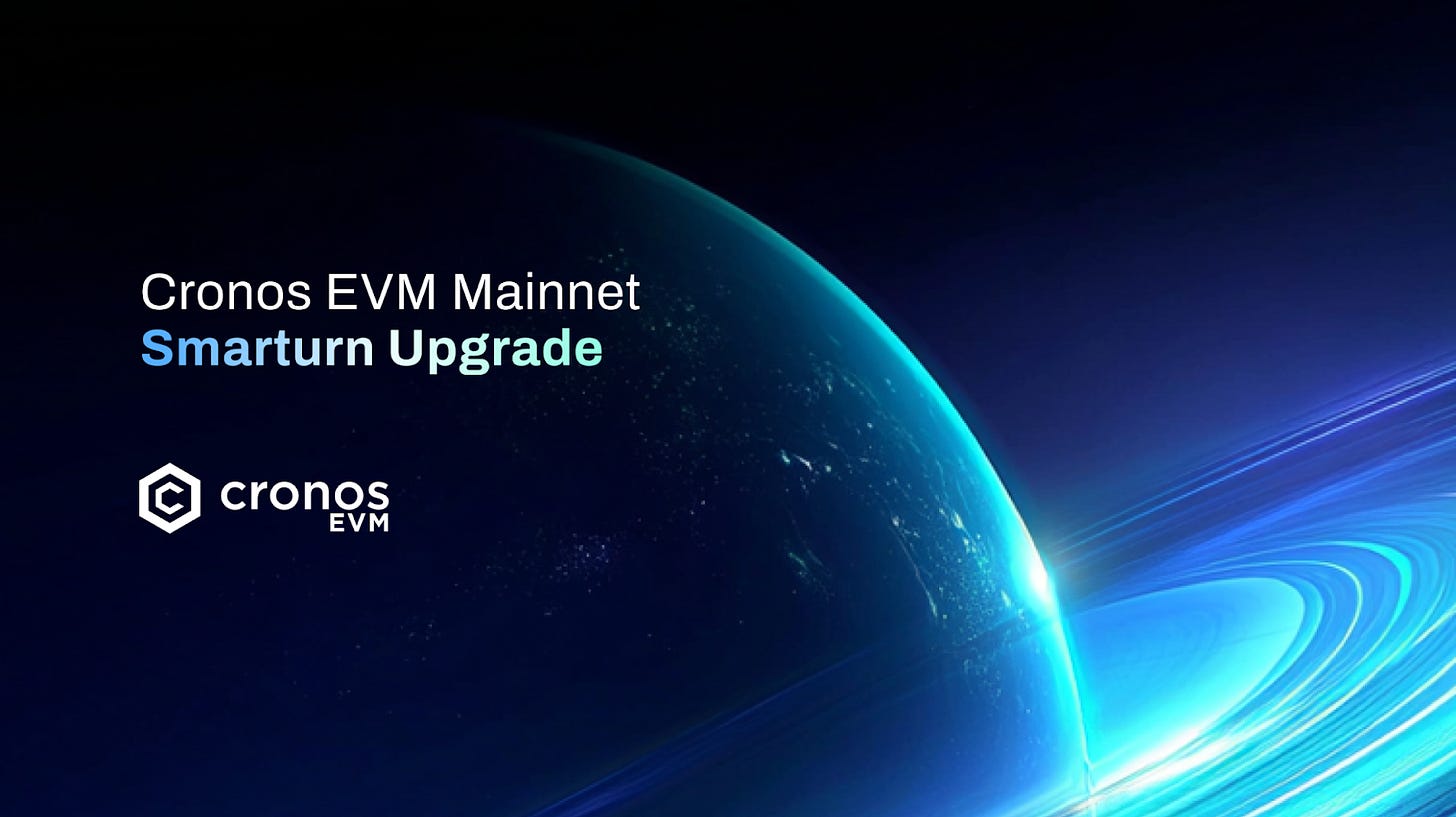We are excited to share the highlights of the upcoming Smarturn Upgrade for the Cronos mainnet, scheduled to go live on October 30, 2025.
This upgrade introduces major protocol improvements across the EVM, including smart accounts, new opcodes, Ethereum client updates, IBC interoperability, and several core performance enhancements.
A Cronos Smarturn upgrade guide for node operators, including target block height and revised estimated date of the upgrade, will be released later in this newsletter.
Smart Accounts: EIP-7702 Support
One key feature of this upgrade is support for smart accounts through EIP‑7702, an Ethereum proposal that allows a regular Externally Owned Account (EOA) to function as a smart contract account, enhancing flexibility and functionality for Dapps and users.
Traditionally, EOAs could only send simple transactions signed with a private key. Smart contract accounts, by contrast, could define custom transaction logic (such as spending limits, batched operations), while they required users to deploy a separate contract wallet.
EIP-7702 bridges this gap by letting EOAs act like smart contracts. The assigned contract code remains valid until the account issues a new authorization, which can apply to one chain or to multiple chains simultaneously.
This enhancement introduces
Enables advanced account abstraction for programmable wallet logic.
Supports bundling multiple transactions for single-operation execution.
Allows application of custom permission rules.
Provides flexible, alternative gas payment management.
all without migrating funds or changing account types.
Go‑ethereum v1.15
Cronos EVM’s VM has been upgraded to run on go-ethereum v1.15.11, aligning with Ethereum’s Cancun and Prague fork roadmap. Cancun fork introduces TSTORE, TLOAD, and MCOPY. This brings new EVM opcodes and extensive client improvements on Cronos that enhance efficiency, debugging, and developer experience.
TSTORE and TLOAD (EIP‑1153) introduce the concept of transient storage, which allows developers to store temporary data within a transaction.
Unlike normal storage operations that permanently write to the blockchain (thus cost more gas), transient storage disappears after execution, significantly lowering gas costs for contracts that need short-lived state (e.g., re-entrancy locks, multi-call logic, and contract-level caching).TSTORE (0x5d): Stores data in transient memory, cleared after the transaction.
TLOAD (0x5c): Reads data from transient memory within the same transaction.
MCOPY (EIP-5656, 0x5e) efficiently copies larger regions of memory with a single instruction, reducing gas for array and buffer operations.
Before this opcode, even a simple 256-byte copy could cost close to 100 gas or more, depending on implementation. with MCOPY, the same operation now costs around 27 gas, dramatically improving performance for contracts that move or process in-memory data.
These opcodes collectively make contract execution more efficient for complex DeFi, gaming contracts that handle multiple operations per transaction, and other computation-heavy applications.
Go‑ethereum v1.15 also brings other key improvements. Interested parties can explore more in their release page. Together, these updates make Cronos’s EVM runtime lighter, faster, and more developer-friendly.
New RPC Endpoint: eth_getBlockReceipts
Cronos developer team also extends the RPC method for eth_getBlockReceipts. This endpoint allows fetching all transaction receipts from a block in a single query, which largely reduces RPC overhead needed for explorers, analytics dashboards, dApp backends, or monitoring tools that need complete block-level data.
New Mempool: Transaction prioritization and Replacement
Cronos v1.5.1 also upgrades its mempool with transaction replacement support.
With this enhancement, users and DApps can replace pending transactions that share the same nonce by resubmitting them with higher gas prices or priority fees.
This enables predictable “speed-up” and “cancel” functionality, a key feature for wallets, trading bots, and DeFi protocols operating under dynamic gas markets. It also improves transaction throughput and responsiveness during periods of high network traffic.
Under the hood, implementation of this PR also integrates PriorityNonceMempool and AnteCache components. These enable smarter transaction ordering, caching, and validation, ensuring high-priority transactions are confirmed faster while preserving correct nonce sequencing and fairness.
IBC Upgrade: ibc-go v10.1.1
We have upgraded to ibc-go v10.1.1, adopting the latest IBC v2 architecture for improved cross-chain performance and developer simplicity.
IBC v2 streamlines how chains communicate by removing redundant channel and connection handshakes, reducing latency, and simplifying integration for new applications, including Ethereum connectivity.
Token transfers and the callbacks middleware are also supported, which potentially enables dApps to automatically trigger logic when cross-chain transactions are completed.
These updates improve reliability and developer experience for IBC-enabled applications.
Furthermore, Cronos has been exploring the partnership with the Interchain Foundation to enable Eureka on Cronos EVM, a next-generation extension that expands IBC’s capabilities for cross-chain data and message exchange, to bring more benefits to our builders and ecosystem.
What’s Next
For those who want to explore further, check out the full Cronos v1.5.1 changelog.
The Cronos team will continue building toward faster, smarter, and more interoperable infrastructure and bringing more capabilities to the Cronos ecosystem.
Stay tuned for more updates and the upcoming Smarturn upgrade guide for node operators.

